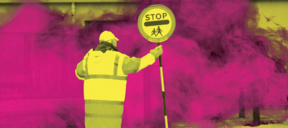"We have no say on what happens in our town": The true extent of tree felling by local authorities
The first part of Noteworthy’s in-depth investigation reveals that over 10,000 trees have been cut down by councils since 2015 with many having incomplete records.

A LOUD, GRINDING noise interrupted Dermot’s early morning shower. He got dressed and stepped outside his home on Orchardstown Drive in Rathfarnham, south county Dublin, only to see a team of workers with trucks and vans using chainsaws to hack pieces off numerous trees on the green.
The devastation of one tree in particular saddened him.
“The cherry blossom had been there for at least 30 years,” Dermot says. “It was a real beauty enjoyed by all the neighbours, and it was in full bloom when they cut it down. The tree was very strong and had withstood many storms. It was not damaging any footpaths or overhanging the road. It was the ideal tree in the ideal location.”
Later, he contacted South Dublin County Council, but says nobody could give him satisfaction on what had happened. “They told residents that the stumps would be removed and ground down, but that it could take a few years. We kicked up a fuss and, within 48 hours, they had removed any evidence that this beloved tree had ever been here.”
***
Dermot is one of many people around Ireland who have been dismayed to see trees being chopped down by local authorities. Over the past four months, Noteworthy has conducted an extensive investigation into tree felling and planting nationwide, under the remit of local authorities.
Trees under local authority management include roadside trees, trees in estates, trees in local parks and various copses, but do not include trees in national parks or Coillte plantations.
In the first part of our investigation, we uncover:
- Since 2015, at least 10,950 trees have been cut down by local authorities. The true figure, however, is likely to be a multiple of this, as many local authorities keep no records of what trees are felled – or why. In the same time period, over 60,000 trees have been planted; however, 40 per cent of these were donated by Wexford County Council under a particular scheme for local community groups to plant.
- Many trees are felled for road-building, including 572 trees chopped in Co Monaghan in 2018 for the N2 upgrade. However, as councils are not obliged to keep any records in relation to their tree management, some residents may find it impossible to hold their local authority to account on this.
- Public money has paid for trees to be bought and planted, yet many local authorities have kept no record of how much was spent or who planted the trees.
- More constituents from the South Dublin County Council area contacted Noteworthy during this investigation with concerns than from any other local authority area, but South Dublin County Council was the only local authority to refuse to provide any information at all.
- Dun Laoghaire Rathdown County Council appears to have felled the highest number of trees, at least in the context of the information that was recorded.
- Some councils have removed or severely pruned the crown of trees in their care, a practice known as “topping”, but one which causes significant damage to trees and, ultimately, exacerbates problems with the tree’s growth. There are many alternatives to topping. This further illustrates the lack of suitable expertise within some local authorities.
Trees under threat
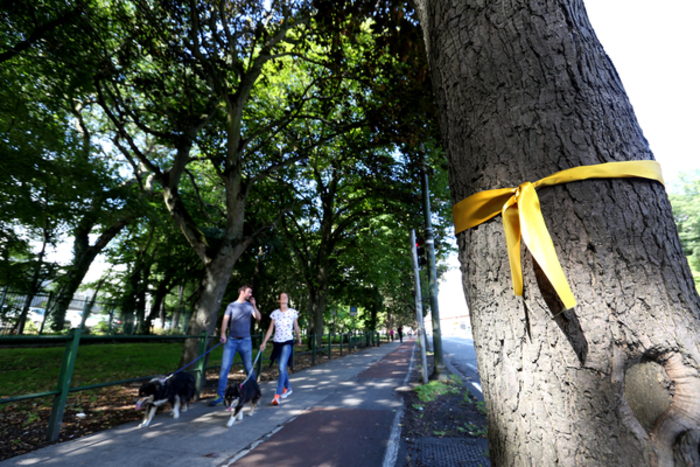 Trees that were earmarked for felling in Fairview in Dublin due to a planned cycle lane, a decision that was subsequently reversed.
Trees that were earmarked for felling in Fairview in Dublin due to a planned cycle lane, a decision that was subsequently reversed.
Trees in our cities, towns, villages and parks are recognised as vital for tackling air pollution, boosting biodiversity, reducing flooding and helping to cool concrete spaces during summer heatwaves, as well as providing people with a proven and much-needed mental health boost. Ireland’s level of tree canopy is relatively low: a study by Dr Gerald Mills, associate professor at the School of Geography in University College Dublin, found that Dublin’s tree canopy covers 10% of the city compared to 57% in world-leader Stockholm.
And, in recent years, a growing number of people throughout Ireland have raised fears that their local trees are under threat.
In Fethard, Co Tipperary, protesters failed to prevent several trees being cut down. In Cork, mature trees have been removed along Glounthaune Road, with more trees removed near the bridge at Glounthaune Village.
Five old trees were removed from the R410 on the Kildare/ Wicklow border, just after Glending Wood in the direction of Blessington to Naas.
In Monaghan, the council removed 572 trees in 2018 to make way for the N2 road upgrade.
In the coming years, trees under local authority management seem likely to become an even-more contentious political issue. A controversial proposal to ease motor traffic congestion on the N11 between Dublin and Wicklow by widening the roadway through the Glen of the Downs nature reserve – one of Ireland’s last-remaining but most significant patches of old-growth oak forest, and the site of a two-year occupation by environmental protesters opposing a similar road widening in the late 1990s – is likely to provoke a storm of protest.
Meanwhile, many local communities throughout Dublin are opposing the removal of healthy trees to make way for the BusConnects plan that transport chiefs say is necessary to improve public transport.
So, which local authorities are taking good care of the trees in their stewardship, and which are falling short?
This project was based around Access to Information on the Environment (AIE) requests – which are similar to the Freedom of Information process – as well as interviews with tree experts and arborists, environmental scientists, campaigners and citizens throughout the country.
- This investigation was carried out by Noteworthy, the investigative journalism platform from TheJournal.ie. It was proposed and funded by you, our readers. Find out more here.
“I arrived back to my house in Burke Street at lunchtime to find my much-loved tree cut right to the stump outside my front door,” a Fethard resident wrote to the local council in Tipperary, in an email released under AIE, one of many complaints the council received about their actions. “To say I was devastated is an understatement. There was no notification that this was on the agenda.
“Fethard Town needs trees to add character and life to what is a historical tourist attractive town, or at least [was] prior to this.
“I would be prepared to incur any costs to replace the tree outside my house. I would be happy to work with [the] county council on an agreement of a more suitable replacement choice – a smaller style if necessary.
“I have never been a citizen who feels the need to raise complaints unnecessarily. But one of the main reasons for me choosing to purchase my house was the fact that Burke Street was tree-lined and my house had this beautiful tree growing in front of it, adding a pretty country feel to a town existence. It also was a regular choice for singing birds to congregate.”
Council documentation records that the trees in Fethard were removed because they were causing damage to footpaths and posed a trip hazard, as well as interfering with overhead power lines. One such trip led to “serious injuries.” Many locals feel the council has overreacted, and have been neglectful in their communication of tree-felling plans, but the council points to a need to prevent people from being injured or killed.
Incomplete felling records
 Stump left after felling of tree by Dublin City Council
Stump left after felling of tree by Dublin City Council
Documents released by some councils show that at least 10,950 trees have been cut down by local authorities since 2015. The true figure is likely to be a multiple of this, however: not all councils record this data methodically, while others only recorded partial data during that time period.
Almost two-thirds of these are recorded as being chopped down from January 2018, but this does not necessarily mean that the rate of tree felling is accelerating: it could be because local authorities have become more systematic about keeping environmental management records in recent years, as many local authorities did not have records pre-dating 2018 at all, while others only had data from 2017 onwards.
- Kildare cut down 1,457 trees between 2015 and June 2019, which is a higher figure than any other county; however, as many councils gave partial or no records and Kildare gave full records, this does mean that they are the worst offender.
- Dun Laoghaire Rathdown cut 1,283 trees between 2017 and 2018, but did not have records for previous years.
- Wexford County Council says it cut just 20 trees in 2018, but did not provide figures for other years.
- Roscommon County Council says it cut just 15 trees in the period 2015 – June 2019, Louth chopped just 38 and Offaly cut down 64 including one which was damaged by vandals.
- Dublin City Council recorded cutting down 602 trees between January 2018 and June 2019, but did have not records before this date. In the same period, Galway City felled 148 trees.
Cork city council says that, “on average, the parks department would remove approximately 200 trees per year,” adding that this happens when “trees are dead, dying, diseased… or pose a danger [or] health and safety risk to the public or buildings. Trees are inspected by the council arborist and where necessary a secondary independent inspection is carried out.”
No records on tree cutting were released from several local authorities, including Carlow, Kerry, Kilkenny, Mayo and South County Dublin. Some other local authorities including Dun Laoghaire, Laois, Monaghan and Wicklow did not record the data every year.
- The full breakdown of trees cut and planted by each local authority can be viewed here.
Destruction in South Dublin
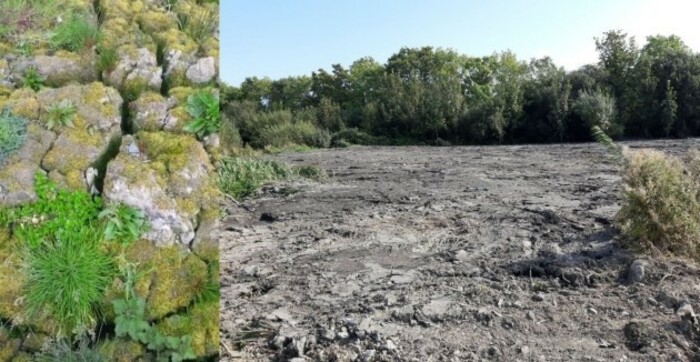 Before / After: Wetlands at Sean Walsh Park
Before / After: Wetlands at Sean Walsh Park
The largest amount of correspondence about trees and wildlife received by Noteworthy came from residents of the South Dublin local authority area, a socio-economically diverse area that includes Clondalkin, Firhouse-Bohernabreena, Lucan, Palmerstown, Fonthill, Rathfarnham, Templeogue and Tallaght.
Earlier this year, Noteworthy revealed that the council failed to carry out any assessment of a biodiverse wetland at Sean Walsh Park in Tallaght before destroying it. They were was roundly criticised for this.
Since then, residents have raised fresh concerns about numerous other wildlife areas under the council’s control. One of these areas is Waterstown Park, a designated wildlife park with a special amenity order on it. Near Palmerstown Village, Dublin’s Strawberry Beds and the Phoenix Park, the park is ecologically significant and has eight different habitats including mature hedgerows, wet grassland and woodland. Home to nearly 300 species of animals and plants, and with a 5km track for walking, jogging and cycling, the park is one of county Dublin’s best spots for watching autumn leaves and spring buds.
“This is not a city park to be manicured and covered in green grass which supports no life,” one local resident told Noteworthy. “Maintenance work has destroyed the habitats of countless birds, insects, invertebrates, otters, hedgehogs, foxes and badger habitat.
“Management [should] be phased to allow nature to adapt. In this time of climate emergency it is outstanding ignorance to destroy ecology like this, just because don’t like a few thorns and think it looks ‘messy’. There is outrage in the local community at this work. We will be fobbed off with an answer about maintenance and enhancement but anyone can see that it is really about spending budgets. Coupled with what happened in the Tallaght wetlands, there is some major systemic issue with the council’s management of natural areas in the county.”
Also in South County Dublin, residents have complained about the “decimation” of mature trees along the Culmore Road in Palmerstown, Dublin 20. “No information [was given] to residents, and no explanations given despite my contacting several local councillors over the last year,” one local told Noteworthy.
Locals in South Dublin have also raised concerns about the destruction of a large area of wild grassland in Dodder Valley Park to accommodate new football pitches. “This area is home to many animals including rabbits and buzzards,” one resident told Noteworthy.
Over 40 trees were cut down in Willbrook (pictured below), an estate in Rathfarnham, South County Dublin.
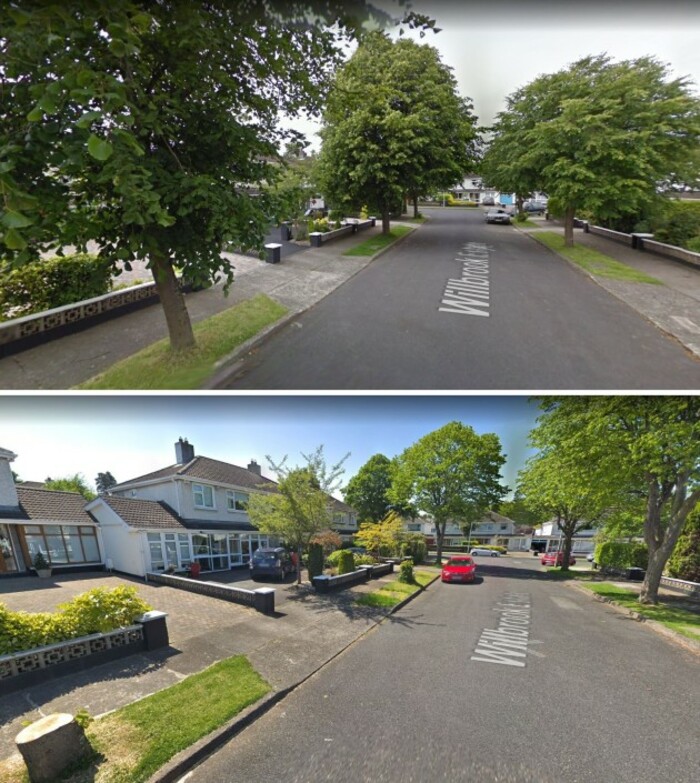 Willbrook Estate: 2009 (above) & 2018 (below)
Willbrook Estate: 2009 (above) & 2018 (below)
Mature cherry and apple blossoms were cut down on the New Road in Clondalkin and around half of them were replaced by saplings.
Based on data from a previous Freedom of Information request lodged by The Irish Times, we know that South County Dublin’s authority cut 1,521 trees in 2018 and 2019 alone.
South Dublin County Council was the only local authority to explicitly refuse to provide any information whatsoever on their tree management.
Noteworthy understands that South Dublin County Council has employed a company to carry out an inventory of trees in its vicinity.
Vague reasons for removal
Noteworthy asked every one of the country’s 31 local authorities to provide information on why it felled trees. The reasons provided were often vague.
Clare County Council says that, between 2016 and 2019, it assessed 556 trees and felled them because they “posed a potential danger to the public”. This is peculiar, because trees are also removed because they are diseased, decaying or causing damage to property, yet the council does not record this in relation to a single tree in the county. A further 219 were removed in 2016 to make way for the Shannon Town Park construction.
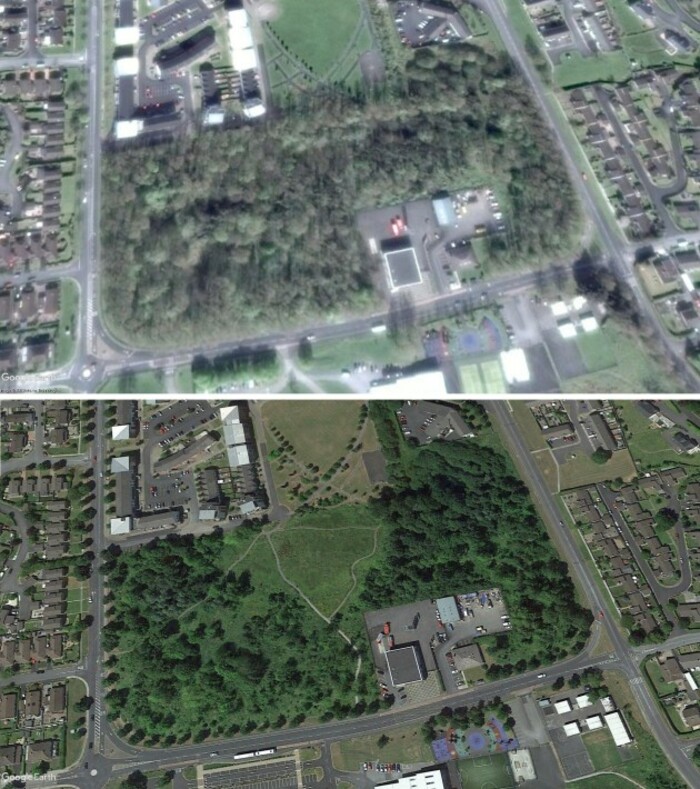 Shannon Town Park: 2012 (above) and 2018 (below)
Shannon Town Park: 2012 (above) and 2018 (below)
In Galway, the local authorities say that several trees had been removed because of storm damage and to improve sight lines. Galway County Council keeps one of the more detailed data sets on tree management. From this data provided to Noteworthy through an AIE request, we compiled a list of trees felled by the council’s housing maintenance section which you can view here.
Dun Laoghaire-Rathdown says that trees are removed if they are dead, dying, diseased or dangerous; if growing within five metres of a lamp standard and blocking the light and where pruning cannot resolve the issue; if they are causing an obstruction; where it is causing a legal nuisance to property (such as damaging the foundations); and where it is deemed necessary to “thin out a wooded area as a management operation in the interest of tree health”.
Controlling the spread of Dutch Elm Disease is a factor in the felling of elm trees.
Other reasons given by councils included road safety issues, dangers caused by power lines, trees decaying or diseased, and trees uprooted or obstructing pedestrians.
Trees can be removed if they are causing structural damage caused to roads and footpaths.
Some trees are removed because they were planted in an inappropriate location, including a row of evergreen leylandii trees in Co Kildare and a number of pear trees in Dublin.
Trees are also being removed to facilitate construction or because they are damaging footpaths and because they represent a trip hazard which is causing local authorities to be sued.
Outside of reasons provided by local authorities, farmers can be potentially be held liable under the 1993 Roads Act if a car hits a tree on their land, which can make them anxious to minimise their own vulnerability. And road safety is a significant issue, with interference caused to sight lines and potential danger of winter storms cited as reasons too. In Dunboyne, Co Meath, oaks were felled because of fears they could kill people during winter storms.
Do the councils’ reasons for felling tally with reality?
But the reasons given for tree removal do not always appear to tally with the situation on the ground and, in many cases, there appears to be a lack of communication from local authorities to residents. In Louth, for instance, new trees planted by Tidy Towns in the Dundalk area were cut down by a contractor, yet the council told Noteworthy that trees were cut down only because of “structure failure, decay or disease.”
Five full trees were cut down here on the Diamond in Ardara Co Donegal and replaced with small newer ones. “Not one local person seems to know why and it seems that we have no say on what happens in our own town,” a local woman says.
In Fethard, one local wrote to the council: “I am shocked you did this without talking to the people of the town.”
In response, Tipperary County Council said that it “does not carry out formal consultation on projects of this scale, as it is essentially a series of small footpath maintenance works at various locations in the town. Informal contact has taken place with some of the residents.”
Maureen O’Sullivan, founder of a small organisation called “Save Ireland’s Trees”, is dubious of the reasons that local authorities claim trees have to be felled. “Councils are quick to claim that tree destruction is carried out because the trees are ‘dangerous’, ‘decayed’ or ‘rotten’, when in the majority of cases no such danger, decay or rot exists,” she says. “Newspapers publish statements like this verbatim without checking the veracity of those statements,” she claims.
Referring to the felling of trees around the Kilternan and Enniskerry area, part of the Dun-Laoghaire Rathdown and Wicklow local authority areas, respectively, O’Sullivan says it is highly unlikely that “decay” was the reason. “When decay occurs in trees it occurs sporadically, at different rates and times in different trees.”
In Fingal, north county Dublin, residents have been contacting local councillors to complain about the large number of trees being removed.
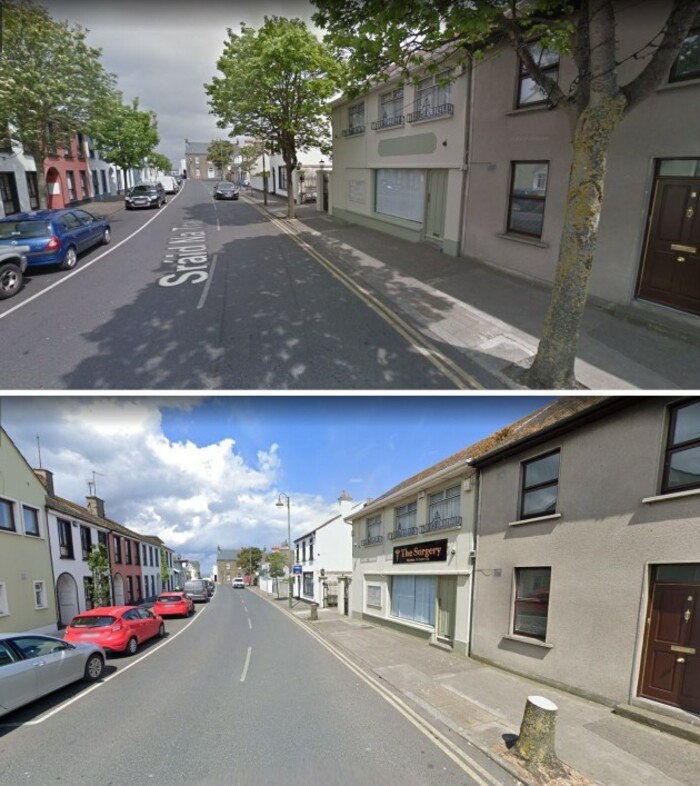 The changing face of Strand Street in Skerries from 2017 (above) to 2019 (below)
The changing face of Strand Street in Skerries from 2017 (above) to 2019 (below)
In May 2019, residents in Fingal were informed by the council of significant tree removal works to be carried out in Skerries, Lush, Rush and Balbriggan.
“The trees to be removed have caused irreversible damage to adjacent public footpaths resulting in serious trip hazards and in some case legal actions against the local authority,” Aileen O’Connor, executive parks superintendent, told colleagues.
“Over the last number of years, paths have been repaired on numerous occasions [but] we are unable to repair these paths any further without the removal of the adjacent street trees. Where possible a more suitable tree species will be planted once path works are complete.”
Records from Fingal show that, between October 2018 to April 2018, 334 trees were cut in Dublin 15 alone.
Conn Donovan, secretary of the Cork Trees Trust, says that there is a general feeling among people interested in environmental issues that there is a “war on trees”, but the truth may be more boring. “People ring Cork City Council about a tree they think (often erroneously) is a danger and the council are happy to ‘remove a threat’ so either prune the tree or cut it down,” he claims.
Trimming for ‘tidiness’
Felling trees isn’t the only way of dealing with possible problems. Topping a tree is a practice whereby the top of tree or large branches are removed from the crown. But it is a controversial practice and one which indicates the lack of suitable arboreal expertise in many local authority areas.
Wohlleben writes that pruning is for aesthetics and that a severely pruned crown is a severe blow for the roots, which have grown to a size optimally suited to serve the above ground tree.
A horticulturalist who has worked with councils says:
Trees are often topped because of a notion of neatness and tidiness. But when you top a tree, it sometimes makes it less safe because it grows back at bad angles and joints. Bad tree surgery can cause trees to become more dangerous.
In its tree strategy, Dublin City Council publishes an appendix by the International Society of Arboriculture which says that “topping is not an acceptable pruning technique… topping stresses trees [and] leads to decay, sunburn.”
The ISA says that it makes trees ugly and it is expensive not just because of the job cost but because, if a topped tree survives, it will need corrective pruning within a few years, and because topped trees pose a risk to the public due to branch failure – and that this risk may lead to insurance claims. The ISA make several alternatives for reducing the height or spread of a tree
The majority of councils do not have records on the number of trees trimmed or “topped” but Monaghan County Council says that it topped 46 trees in 2019. Kildare County Council says it pruned 821 trees between 2015 and mid-2019. Kilkenny County Council says it carries out a programme of tree surgery every winter, based on issues raised by members of the public.
Laois County Council says that 61 trees were trimmed or topped in Portlaoise between 2015 and mid-2019. Wicklow County Council has documented the topping of 72 trees during the same period, but it admitted that “this may not be the total number of trees topped as the council does not document tree topping in all areas.”
Offaly topped nine poplar trees in Tullamore in 2015 because they were causing damage to infrastructure.
Above is Nenagh’s Dark Road after Tipperary County Council instructed a local landowner to cut the trees earlier this year, after a large tree fell on the road in 2015.
In Wexford, the council says that topping and trimming is carried out in the main urban areas of Wexford, Enniscorthy, New Ross, Gorey and Bunclody, and is confined to tree-lined streets. The work is done every two years on an estimated 50 trees.
“The main reason for topping and trimming is to prevent interference with passing traffic and adjoining buildings,” the council says.
No records on topping were released from several local authorities, including Carlow, Dublin City, Kerry, Galway city, Kilkenny, Mayo and South County Dublin. Some other local authorities including Dun Laoghaire, Laois, Monaghan and Wicklow did not record the data every year.
Over 60,000 trees planted
There’s more to local authority tree management than simply topping, pruning or cutting them down, however. For all the trees felled, are local authorities stepping up to plant new ones? Here, there may be some good news.
Local authority records show that 60,463 trees have been planted nationally – almost six times more than the numbers felled. The true figure is significantly higher because no records or figures were provided by several counties, including Carlow, Cavan, Clare, Galway city, Kerry and Longford. Some districts of Meath, particularly Trim, keep detailed records but other parts of the county keep no records at all.
The single largest record of new trees is in Co Wexford, where the council gave out 26,034 trees to local community groups for planting between 2015 and 2018. This represents 43 per cent of the total number of trees recorded as planted nationally, although not all of the trees may have been planted.
Dublin City Council provided a record of the number of trees planted in 2015 including 450 in open space, 968 on roadside and 541 in parkland. Of these, 1,243 were replacing trees that had been cut down and 716 were new. However, there were no records beyond this year.
- Fingal County Council says it planted 649 trees since 2015.
- Galway County Council says it planted over 5,592 trees from 2016.
- In Cork city, the council says it plants approximately 200 trees a year.
- The local authority in Limerick says that planted 843 trees including 780 in the city including alder, birch, mountain ash and oak.
- Sligo County Council says it has planted just 20 but intends to plant 40 trees in 2021 and 100 in 2022, as well as additional trees which will be planted on the N4 Collooney to Castlebaldwin Road under a proposed landscaping plan.
- Local authorities in Westmeath, Waterford and Wicklow say that they planted 2,235, 2,272 and 4,692, respectively.
No records were released from several local authorities, including Carlow, Kerry, Galway City, Kilkenny, Mayo and South County Dublin. Some other local authorities including Dun Laoghaire, Laois, Monaghan and Wicklow did not record the data every year. Laois and Kilkenny only had partial records.
***
UCC’s Dr Eoin Lettice says that we need more accountability and transparency. “The local authorities paid for these trees and paid for them to be planted. At some point, public money was handed over, so what has happened to these assets? We need better oversight than this.”
A study by Dr Gerald Mills, associate professor at the School of Geography in University College Dublin, found that Dublin has just 10% canopy tree cover, and most of this is concentrated in the wealthiest parts of the city. There are between 8 and 10 residents for every tree in Dublin 4, compared to 30 residents for every tree in Dublin 1. In Stockholm, one of the world leaders in tree management, tree canopy cover figure is 57%, followed by Helsinki (49%), and Warsaw (36%).
The tree cover “statistics are useful but a lot depends on how the city boundary is drawn”, according to Mills. “Not surprisingly you will find that south Dublin, for example, has a high tree cover because of all the Coillte forests in the mountains. Similarly, Fingal is very green but has a low tree cover as it is mostly agricultural land. So comparisons are hard to do.”
 Fairview Park in Dublin 3 is one of the few areas on the north side of the city with more than 20% tree cover.
Fairview Park in Dublin 3 is one of the few areas on the north side of the city with more than 20% tree cover.
Further afield, UCC’s Dr Lettice points to Singapore’s tree management as an example of best practice. “They have taken the decision to become a garden city, with massive gardens and large amounts of trees in the heart of the city. For the city, it means shade, homes for wildlife and increased biodiversity, reduced air pollution, carbon sequestration, a valuable visual amenity, increased home values and a major tourist attraction.
“They have mapped every tree in the city on a website, and you can zoom in on it, check its height, details and the functions it performs, as well as what maintenance is being done on it and why. Councils here should do the same, but there can be a reluctance to plant trees on streets because of perceived problems they might cause.”
So what is stopping local authorities from more transparent, and expert, management of the trees in their care?
We reveal more about the reasons behind tree felling by local authorities, and some projects to aspire to, in the second part of our investigation which you can read here.
***

This investigation was carried out by Noteworthy, the investigative journalism platform from TheJournal.ie. It was proposed and funded by you, our readers, as well as with support from the Noteworthy general fund to cover additional costs.
You can support our work by helping to fund one of our other investigation proposals or submitting an idea for a story. Click here to find out more >>







